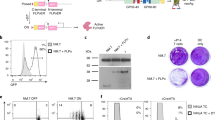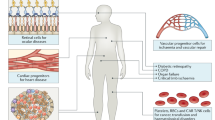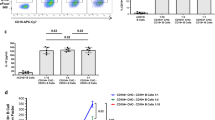Abstract
Class II transactivator (CIITA) induces transcription of major histocompatibility complex (MHC) II genes and can potentially be used to improve genetic immunotherapies by converting non-immune cells into cells capable of presenting antigens to CD4+ T cells. However, CIITA expression is tightly controlled and it remains unclear whether distinct non-immune cells differ in this transactivator regulation. Here we describe the development of gene delivery systems capable of promoting the efficient CIITA expression in non-immune cell lines and in primary human cells of an ex vivo skin explant model. Different human cell types undergoing CIITA overexpression presented high-level de novo expression of MHC II, validating the delivery systems as suitable tools for the CIITA evaluation as a molecular adjuvant for gene therapies.
This is a preview of subscription content, access via your institution
Access options
Subscribe to this journal
Receive 12 print issues and online access
$259.00 per year
only $21.58 per issue
Buy this article
- Purchase on Springer Link
- Instant access to full article PDF
Prices may be subject to local taxes which are calculated during checkout





Similar content being viewed by others
References
Kern I, Steimle V, Siegrist CA, Mach B . The two novel MHC class II transactivators RFX5 and CIITA both control expression of HLA-DM genes. Int Immunol 1995; 7: 1295–1299.
Taxman DJ, Cressman DE, Ting JP . Identification of class II transcriptional activator-induced genes by representational difference analysis: discoordinate regulation of the DN alpha/DO beta heterodimer. J Immunol 2000; 165: 1410–1416.
Westerheide SD, Louis-Plence P, Ping D, He XF, Boss JM . HLA-DMA and HLA-DMB gene expression functions through the conserved S-X-Y region. J Immunol 1997; 158: 4812–4821.
Jordan ET, Collins M, Terefe J, Ugozzoli L, Rubio T . Optimizing electroporation conditions in primary and other difficult-to-transfect cells. J Biomol Tech 2008; 19: 328–334.
Muhlethaler-Mottet A, Otten LA, Steimle V, Mach B . Expression of MHC class II molecules in different cellular and functional compartments is controlled by differential usage of multiple promoters of the transactivator CIITA. EMBO J 1997; 16: 2851–2860.
Lohsen S, Majumder P, Scharer CD, Barwick BG, Austin JW, Zinzow-Kramer WM et al. Common distal elements orchestrate CIITA isoform-specific expression in multiple cell types. Genes Immun 2014; 15: 543–555.
Xia J, Fang M, Wu X, Yang Y, Yu L, Xu H et al. A2b adenosine signaling represses CIITA transcription via an epigenetic mechanism in vascular smooth muscle cells. Biochim Biophys Acta 2015; 1849: 665–676.
Wright KL, Ting JP . Epigenetic regulation of MHC-II and CIITA genes. Trends Immunol 2006; 27: 405–412.
De Lerma Barbaro A, Procopio FA, Mortara L, Tosi G, Accolla RS . The MHC class II transactivator (CIITA) mRNA stability is critical for the HLA class II gene expression in myelomonocytic cells. Eur J Immunol 2005; 35: 603–611.
Asirvatham AJ, Gregorie CJ, Hu Z, Magner WJ, Tomasi TB . MicroRNA targets in immune genes and the Dicer/Argonaute and ARE machinery components. Mol Immunol 2008; 45: 1995–2006.
Morgan JE, Shanderson RL, Boyd NH, Cacan E, Greer SF . The class II transactivator (CIITA) is regulated by post-translational modification cross-talk between ERK1/2 phosphorylation, mono-ubiquitination and Lys63 ubiquitination. Biosci Rep 2015; 35: e00233.
Spilianakis C, Papamatheakis J, Kretsovali A . Acetylation by PCAF enhances CIITA nuclear accumulation and transactivation of major histocompatibility complex class II genes. Mol Cell Biol 2000; 20: 8489–8498.
Greer SF, Zika E, Conti B, Zhu XS, Ting JP . Enhancement of CIITA transcriptional function by ubiquitin. Nat Immunol 2003; 4: 1074–1082.
Kong X, Fang M, Li P, Fang F, Xu Y . HDAC2 deacetylates class II transactivator and suppresses its activity in macrophages and smooth muscle cells. J Mol Cell Cardiol 2009; 46: 292–299.
Sisk TJ, Nickerson K, Kwok RP, Chang CH . Phosphorylation of class II transactivator regulates its interaction ability and transactivation function. Int Immunol 2003; 15: 1195–1205.
Bhat KP, Truax AD, Greer SF . Phosphorylation and ubiquitination of degron proximal residues are essential for class II transactivator (CIITA) transactivation and major histocompatibility class II expression. J Biol Chem 2010; 285: 25893–25903.
Bhat KP, Truax AD, Brooks JK, Greer SF . Association of the 19 S proteasomal ATPases with the ATPase-binding domain of CIITA is essential for CIITA stability and MHC class II expression. Immunol Cell Biol 2010; 88: 807–816.
Ulbricht T, Alzrigat M, Horch A, Reuter N, von Mikecz A, Steimle V et al. PML promotes MHC class II gene expression by stabilizing the class II transactivator. J Cell Biol 2012; 199: 49–63.
Gialitakis M, Arampatzi P, Makatounakis T, Papamatheakis J . Gamma interferon-dependent transcriptional memory via relocalization of a gene locus to PML nuclear bodies. Mol Cell Biol 2010; 30: 2046–2056.
Thompson JA, Dissanayake SK, Ksander BR, Knutson KL, Disis ML, Ostrand-Rosenberg S . Tumor cells transduced with the MHC class II transactivator and CD80 activate tumor-specific CD4+ T cells whether or not they are silenced for invariant chain. Cancer Res 2006; 66: 1147–1154.
Lu X, Kallinteris NL, Li J, Wu S, Li Y, Jiang Z et al. Tumor immunotherapy by converting tumor cells to MHC class II-positive, Ii protein-negative phenotype. Cancer Immunol Immunother 2003; 52: 592–598.
Meazza R, Comes A, Orengo AM, Ferrini S, Accolla RS . Tumor rejection by gene transfer of the MHC class II transactivator in murine mammary adenocarcinoma cells. Eur J Immunol 2003; 33: 1183–1192.
Wang Y, Xu M, Che M, Von Hofe E, Abbas A, Kallinteris NL et al. Curative antitumor immune response is optimal with tumor irradiation followed by genetic induction of major histocompatibility complex class I and class II molecules and suppression of Ii protein. Hum Gene Ther 2005; 16: 187–199.
Mortara L, Castellani P, Meazza R, Tosi G, De Lerma Barbaro A, Procopio FA et al. CIITA-induced MHC class II expression in mammary adenocarcinoma leads to a Th1 polarization of the tumor microenvironment, tumor rejection, and specific antitumor memory. Clin Cancer Res 2006; 12 (11 Pt 1): 3435–3443.
Mortara L, Frangione V, Castellani P, De Lerma Barbaro A, Accolla RS . Irradiated CIITA-positive mammary adenocarcinoma cells act as a potent anti-tumor-preventive vaccine by inducing tumor-specific CD4+ T cell priming and CD8+ T cell effector functions. Int Immunol 2009; 21: 655–665.
Frangione V, Mortara L, Castellani P, De Lerma Barbaro A, Accolla RS . CIITA-driven MHC-II positive tumor cells: preventive vaccines and superior generators of antitumor CD4+ T lymphocytes for immunotherapy. Int J Cancer 2010; 127: 1614–1624.
Kim D, Hoory T, Monie A, Ting JP, Hung CF, Wu TC . Enhancement of DNA vaccine potency through coadministration of CIITA DNA with DNA vaccines via gene gun. J Immunol 2008; 180: 7019–7027.
Clark KR, Johnson PR . Gene delivery of vaccines for infectious disease. Curr Opin Mol Ther 2001; 3: 375–384.
Green MR, Yoon H, Boss JM . Epigenetic regulation during B cell differentiation controls CIITA promoter accessibility. J Immunol 2006; 177: 3865–3873.
Smith MA, Wright G, Wu J, Tailor P, Ozato K, Chen X et al. Positive regulatory domain I (PRDM1) and IRF8/PU.1 counter-regulate MHC class II transactivator (CIITA) expression during dendritic cell maturation. J Biol Chem 2011; 286: 7893–7904.
Schlahsa L, Zhang H, Battermann A, Verboom M, Immenschuh S, Eiz-Vesper B et al. Semaphorin 3 A alters endothelial cell immunogenicity by regulating class II transactivator activity circuits. Transfusion 2014; 54: 1961–1970.
LeibundGut-Landmann S, Waldburger JM, Krawczyk M, Otten LA, Suter T, Fontana A et al. Mini-review: Specificity and expression of CIITA, the master regulator of MHC class II genes. Eur J Immunol 2004; 34: 1513–1525.
Bontron S, Ucla C, Mach B, Steimle V . Efficient repression of endogenous major histocompatibility complex class II expression through dominant negative CIITA mutants isolated by a functional selection strategy. Mol Cell Biol 1997; 17: 4249–4258.
Beaulieu YB, Leon Machado JA, Ethier S, Gaudreau L, Steimle V . Degradation, promoter recruitment and transactivation mediated by the extreme N-terminus of MHC class II transactivator CIITA isoform III. PLoS ONE 2016; 11: e0148753.
Steimle V, Otten LA, Zufferey M, Mach B . Complementation cloning of an MHC class II transactivator mutated in hereditary MHC class II deficiency (or bare lymphocyte syndrome). Cell 1993; 75: 135–146.
Kozak M . Determinants of translational fidelity and efficiency in vertebrate mRNAs. Biochimie 1994; 76: 815–821.
Maciel M Jr, Cruz Fda S, Cordeiro MT, da Motta MA, Cassemiro KM, Maia Rde C et al. A DNA vaccine against yellow fever virus: development and evaluation. PLoS Negl Trop Dis 2015; 9: e0003693.
Greer SF, Harton JA, Linhoff MW, Janczak CA, Ting JP, Cressman DE . Serine residues 286, 288, and 293 within the CIITA: a mechanism for down-regulating CIITA activity through phosphorylation. J Immunol 2004; 173: 376–383.
Voong LN, Slater AR, Kratovac S, Cressman DE . Mitogen-activated protein kinase ERK1/2 regulates the class II transactivator. J Biol Chem 2008; 283: 9031–9039.
Cressman DE, O'Connor WJ, Greer SF, Zhu XS, Ting JP . Mechanisms of nuclear import and export that control the subcellular localization of class II transactivator. J Immunol 2001; 167: 3626–3634.
Schnappauf F, Hake SB, Camacho Carvajal MM, Bontron S, Lisowska-Grospierre B, Steimle V . N-terminal destruction signals lead to rapid degradation of the major histocompatibility complex class II transactivator CIITA. Eur J Immunol 2003; 33: 2337–2347.
Chiu E, Gold T, Fettig V, LeVasseur MT, Cressman DE . Identification of a nuclear export sequence in the MHC CIITA. J Immunol 2015; 194: 6102–6111.
Camacho-Carvajal MM, Klingler S, Schnappauf F, Hake SB, Steimle V . Importance of class II transactivator leucine-rich repeats for dominant-negative function and nucleo-cytoplasmic transport. Int Immunol 2004; 16: 65–75.
Raval A, Weissman JD, Howcroft TK, Singer DS . The GTP-binding domain of class II transactivator regulates its nuclear export. J Immunol 2003; 170: 922–930.
Wu X, Kong X, Chen D, Li H, Zhao Y, Xia M et al. SIRT1 links CIITA deacetylation to MHC II activation. Nucleic Acids Res 2011; 39: 9549–9558.
Muller S, Matunis MJ, Dejean A . Conjugation with the ubiquitin-related modifier SUMO-1 regulates the partitioning of PML within the nucleus. EMBO J 1998; 17: 61–70.
Chang CH, Fontes JD, Peterlin M, Flavell RA . Class II transactivator (CIITA) is sufficient for the inducible expression of major histocompatibility complex class II genes. J Exp Med 1994; 180: 1367–1374.
Harton JA, Ting JP . Class II transactivator: mastering the art of major histocompatibility complex expression. Mol Cell Biol 2000; 20: 6185–6194.
Barbaro Ade L, Tosi G, Frumento G, Bruschi E, D'Agostino A, Valle MT et al. Block of Stat-1 activation in macrophages phagocytosing bacteria causes reduced transcription of CIITA and consequent impaired antigen presentation. Eur J Immunol 2002; 32: 1309–1318.
Gresch O, Altrogge L . Transfection of difficult-to-transfect primary mammalian cells. Methods Mol Biol 2012; 801: 65–74.
Hu B, Tai A, Wang P . Immunization delivered by lentiviral vectors for cancer and infectious diseases. Immunol Rev 2011; 239: 45–61.
He Y, Falo LD Jr . Lentivirus as a potent and mechanistically distinct vector for genetic immunization. Curr Opin Mol Ther 2007; 9: 439–446.
Rice AD, Adams MM, Lindsey SF, Swetnam DM, Manning BR, Smith AJ et al. Protective properties of vaccinia virus-based vaccines: skin scarification promotes a nonspecific immune response that protects against orthopoxvirus disease. J Virol 2014; 88: 7753–7763.
Tan PH, Beutelspacher SC, Xue SA, Wang YH, Mitchell P, McAlister JC et al. Modulation of human dendritic-cell function following transduction with viral vectors: implications for gene therapy. Blood 2005; 105: 3824–3832.
Breckpot K, Emeagi P, Dullaers M, Michiels A, Heirman C, Thielemans K . Activation of immature monocyte-derived dendritic cells after transduction with high doses of lentiviral vectors. Hum Gene Ther 2007; 18: 536–546.
Croft M, Dubey C . Accessory molecule and costimulation requirements for CD4 T cell response. Crit Rev Immunol 1997; 17: 89–118.
Sartoris S, Valle MT, Barbaro AL, Tosi G, Cestari T, D'Agostino A et al. HLA class II expression in uninducible hepatocarcinoma cells after transfection of AIR-1 gene product CIITA: acquisition of antigen processing and presentation capacity. J Immunol 1998; 161: 814–820.
Martinez-Soria E, Siegrist CA, Mach B . Highly efficient peptide binding and T cell activation by MHC class II molecules of CIITA-transfected cells. Int Immunol 1996; 8: 543–549.
Fan W, Tian XD, Huang E, Zhang JJ . Exosomes from CIITA-transfected CT26 cells enhance anti- tumor effects. Asian Pac J Cancer Prev 2013; 14: 987–991.
Zhou X, Jiang Y, Lu L, Ding Q, Jiao Z, Zhou Y et al. MHC class II transactivator represses human IL-4 gene transcription by interruption of promoter binding with CBP/p300, STAT6 and NFAT1 via histone hypoacetylation. Immunology 2007; 122: 476–485.
Sisk TJ, Gourley T, Roys S, Chang CH . MHC class II transactivator inhibits IL-4 gene transcription by competing with NF-AT to bind the coactivator CREB binding protein (CBP)/p300. J Immunol 2000; 165: 2511–2517.
Yee CS, Yao Y, Xu Q, McCarthy B, Sun-Lin D, Tone M et al. Enhanced production of IL-10 by dendritic cells deficient in CIITA. J Immunol 2005; 174: 1222–1229.
Wong AW, Brickey WJ, Taxman DJ, van Deventer HW, Reed W, Gao JX et al. CIITA-regulated plexin-A1 affects T-cell-dendritic cell interactions. Nat Immunol 2003; 4: 891–898.
Gourley TS, Patel DR, Nickerson K, Hong SC, Chang CH . Aberrant expression of Fas ligand in mice deficient for the MHC class II transactivator. J Immunol 2002; 168: 4414–4419.
Barbieri G, Deffrennes V, Prod'homme T, Vedrenne J, Baton F, Cortes C et al. Isoforms of the class II transactivator protein. Int Immunol 2002; 14: 839–848.
Rousseau A, Bertolotti A . An evolutionarily conserved pathway controls proteasome homeostasis. Nature 2016; 536: 184–189.
Ishov AM, Sotnikov AG, Negorev D, Vladimirova OV, Neff N, Kamitani T et al. PML is critical for ND10 formation and recruits the PML-interacting protein daxx to this nuclear structure when modified by SUMO-1. J Cell Biol 1999; 147: 221–234.
Zhong S, Muller S, Ronchetti S, Freemont PS, Dejean A, Pandolfi PP . Role of SUMO-1-modified PML in nuclear body formation. Blood 2000; 95: 2748–2752.
Nagarajan UM, Bushey A, Boss JM . Modulation of gene expression by the MHC class II transactivator. J Immunol 2002; 169: 5078–5088.
Scharer CD, Choi NM, Barwick BG, Majumder P, Lohsen S, Boss JM . Genome-wide CIITA-binding profile identifies sequence preferences that dictate function versus recruitment. Nucleic Acids Res 2015; 43: 3128–3142.
Nakamura MC . CIITA: a master regulator of adaptive immunity shows its innate side in the bone. J Bone Miner Res 2014; 29: 287–289.
Xu Y, Farmer SR, Smith BD . Peroxisome proliferator-activated receptor gamma interacts with CIITA x RFX5 complex to repress type I collagen gene expression. J Biol Chem 2007; 282: 26046–26056.
Fynan EF, Webster RG, Fuller DH, Haynes JR, Santoro JC, Robinson HL . DNA vaccines: protective immunizations by parenteral, mucosal, and gene-gun inoculations. Proc Natl Acad Sci USA 1993; 90: 11478–11482.
Feltquate DM, Heaney S, Webster RG, Robinson HL . Different T helper cell types and antibody isotypes generated by saline and gene gun DNA immunization. J Immunol 1997; 158: 2278–2284.
Oliveira SC, Rosinha GM, de-Brito CF, Fonseca CT, Afonso RR, Costa MC et al. Immunological properties of gene vaccines delivered by different routes. Braz J Med Biol Res 1999; 32: 207–214.
Belperron AA, Feltquate D, Fox BA, Horii T, Bzik DJ . Immune responses induced by gene gun or intramuscular injection of DNA vaccines that express immunogenic regions of the serine repeat antigen from Plasmodium falciparum. Infect Immun 1999; 67: 5163–5169.
McCluskie MJ, Brazolot Millan CL, Gramzinski RA, Robinson HL, Santoro JC, Fuller JT et al. Route and method of delivery of DNA vaccine influence immune responses in mice and non-human primates. Mol Med 1999; 5: 287–300.
Mah C, Fraites TJ Jr, Cresawn KO, Zolotukhin I, Lewis MA, Byrne BJ . A new method for recombinant adeno-associated virus vector delivery to murine diaphragm. Mol Ther 2004; 9: 458–463.
Weber K, Bartsch U, Stocking C, Fehse B . A multicolor panel of novel lentiviral 'gene ontology' (LeGO) vectors for functional gene analysis. Mol Ther 2008; 16: 698–706.
Douradinha B, McBurney SP, Soares de Melo KM, Smith AP, Krishna NK, Barratt-Boyes SM et al. C1q binding to dengue virus decreases levels of infection and inflammatory molecules transcription in THP-1 cells. Virus Res 2014; 179: 231–234.
Toniolo PA, Liu S, Yeh JE, Moraes-Vieira PM, Walker SR, Vafaizadeh V et al. Inhibiting STAT5 by the BET bromodomain inhibitor JQ1 disrupts human dendritic cell maturation. J Immunol 2015; 194: 3180–3190.
Livak KJ, Schmittgen TD . Analysis of relative gene expression data using real-time quantitative PCR and the 2(-Delta Delta C(T)) method. Methods 2001; 25: 402–408.
Beyer WR, Westphal M, Ostertag W, von Laer D . Oncoretrovirus and lentivirus vectors pseudotyped with lymphocytic choriomeningitis virus glycoprotein: generation, concentration, and broad host range. J Virol 2002; 76: 1488–1495.
Acknowledgements
This work was supported by the Fundação de Amparo a Pesquisa do Estado de São Paulo Grants 2011/20649-6, 2011/12134-6 and 2012/22171-9 and by the Fondazione Ri.MED. BD is a Fondazione Ri.MED Associate Scholar. We thank Stefan P Lamers for manuscript editing. We also acknowledge Dr Patrícia A Toniolo and Dr Elizabeth R Wonderlich for assistance with the lentivirus transduction system, and Dr Jared Evans for kindly providing the pcDNAl-eGFP plasmid.
Author contributions
MLP designed, performed and analyzed most of the experiments, and wrote the manuscript. PD performed the skin explant inoculations, immunohistochemistry, acquisition of confocal images and the density of markers quantification in confocal images. BD designed, performed and analyzed the quantitative real-time PCR assays. IFTV provided technical assistance. RD performed the artificial sequence design and optimization. POR provided technical assistance. EJMN, TMO, RBM, SMBB, AJSD and ETAM Jr conceived and supervised the study.
Author information
Authors and Affiliations
Corresponding author
Ethics declarations
Competing interests
The authors declare no conflict of interest.
Additional information
Supplementary Information accompanies this paper on Gene Therapy website
Rights and permissions
About this article
Cite this article
Palma, M., Duangkhae, P., Douradinha, B. et al. Development of potent class II transactivator gene delivery systems capable of inducing de novo MHC II expression in human cells, in vitro and ex vivo. Gene Ther 24, 342–352 (2017). https://doi.org/10.1038/gt.2017.25
Received:
Revised:
Accepted:
Published:
Issue Date:
DOI: https://doi.org/10.1038/gt.2017.25
This article is cited by
-
Evolving Insights for MHC Class II Antigen Processing and Presentation in Health and Disease
Current Pharmacology Reports (2017)



